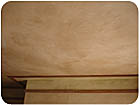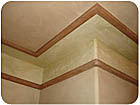
This location is in an older home. They didn't want to do the whole wall over and were not interested in taking the wallpaper off; just a simple repair is all they wanted. I thought it gave a good example of how to handle a place where wallpaper was present around the area being repaired.
The first step was to set up the stairway for the demolition of the bulged area. I cut the wallpaper back around the area to be repaired to allow plenty of space for feathering out the finish coat at the end. The bulged plaster I cut out back to where it was solid but I had a problem: The plaster in this older home was about 3/8-inch thick. They were short on 3/8-inch board in our area and all they had was 1/2 inch.
So, I ended up taking the wood lath out, which gave me more room for the board (not something I like to do but it worked for this situation). I filled the hole with 1/2-inch board, applied some construction adhesive between the wood lath and existing plaster around the edge, and put in some screws around the edge to hold the plaster in place securely, so that was set. I bonded the area around the hole right up to the edge of the wallpaper I left in place.
To bridge between the existing plaster and the repair area, I used basecoat and heavy fiberglass mesh. What they did to this area from here on out was their decision but at least the bulge was gone and that had been driving them nuts looking at it for years.

Expectations and a plan of action
This is a perfect example of knowing what the homeowner wants, as well as how we can work with them to a good effect. I've seen plasterers who felt strongly on doing the area in question a certain way-and they walked away from doing a repair because they felt the whole wall either needed to be taken down or resurfaced completely. Hard to believe but true. My motto is to give the homeowner what they want, whenever you can. Do a good job of doing the repair and let them decide what they want to do with the wall or area from there on out.One thing I wanted to bring out was how the timing went with this project. I knew it was going to take some time for the construction adhesive to set and the bonder to dry. I didn't want to sit around and wait, so I scheduled it like this: I came in around 7:00 a.m. and did the demolition work, loading up the debris that needed to be taken away. I bonded and secured the area around the edge, and put in the 1/2-inch board. Then I headed out for another repair in town and arranged to come back later that afternoon.
I went and did another repair that lasted until about 2:00 p.m. When I was done with that repair work, the last thing I did before loading up was mixing up some basecoat. I took that back over, filled in and applied the fiberglass mesh into the basecoat. This way, I used the day wisely and got the maximum amount out of every minute that was available. All it took was setting this up ahead of time with the homeowners, who were more than happy to cooperate with my schedule.
Materials, timing and pricing
On this particular repair, I used about half of a 5-gallon bucket-about 20 pounds of basecoat. I made one batch of finish for the smooth coat. The total time to do the work was about two-and-a-half hours from start to finish.As far as pricing, I approached it as a way to give the lady a deal. I knew it was not a problem with her for me to come back twice in the same day. But since she worked with me on this, I thought I'd give her a break on the pricing. I was able to do two repairs in the same day. So, I had these figures going around in my head: Setting up, securing and stabilizing the area, which took in everything up to the point of basecoating ($150); basecoat and embedded mesh I figured about $150, and the finish coat another $125. So, the total came up to $425. I was able, as I mentioned, to do another repair that brought in an additional $575, so I made my goal of $750 per day and then some.
The workshop and something new
The five-day Plaster Man Live Workshop turned out better than I had imagined. We had attendees from at least 12 states and I thank all those who attended. The knowledge that was shared by the many instructors present (from Michigan, Idaho, Vermont and Iowa) during the programs was amazing to say the least.One couple that attended the first two days of the workshop, Jake and Gina Caval, from Idaho, were enthusiastic about the new plaster they wanted to show me. Jake owns Cavalli Corp. (check out www.cavallicorp.com to find out more) and has invented the Infinito Decorative Interior Fresco plaster.
Jake originally came from Romania and was taught there at a very young age the art of plastering by his cousin. But he wanted to make a unique plaster, with a larger open/working time that kept its rich color, especially the darker colors. He combined natural pigments with a plaster that is super easy to apply and also has the benefit of holding deep, rich colors that don't fade away as it dries.
The thing that really knocked me over was that a crew can keep the same consistent look over an entire room. To describe it, this is applied in a larger setting that one person would apply the first color as a base for the whole wall area; a second person would follow, applying the second color; finally a third person would apply the third color. Now either the first person, or a fourth person, would come behind and blend the colors together while the plaster is still wet. This is why Jake decided to call it a fresco, as it has such depth and elegance. It's a flatter finish than Marmorino plasters but to me it sets it in a class by itself.
Check out the picture gallery on the Web site and you'll be able to see some more examples of this plaster. If you want to learn how to apply this plaster or other issues, contact me through this magazine or e-mail me at robin@plasterzone.com.
Congratulations go out to Tony Winters of Turlock, Calif., the latest winner of the Plaster Man/Walls & CeilingsT-shirt and also to Tim Hopkins of St. Louis, winner of the Bosch Radio. Keep your e-mails coming. I do appreciate the comments, questions and words of advice. I'll announce the next contest next time around. Until then, Plaster On!
If you read this article, please circle number 339.




